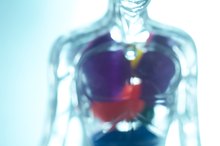Stool Symptoms of Hepatitis C
**When you think about hepatitis, the first thing that comes to mind is probably your liver.
If you are experiencing serious medical symptoms, seek emergency treatment immediately.
** But infection with the hepatitis C virus can lead to stool symptoms as well. Diarrhea can occur in the early or late stages of hepatitis C infection, or it may be a side effect of medications used to treat the virus. Severe liver disease may also cause pale, oily, bloody or tar-like stools. If you have hepatitis C, it is important to be aware of stool symptoms, as they are often an indicator of disease severity, and some require prompt medical care.
Early Diarrhea
Diarrhea -- that annoying occurrence of frequent and loose or liquidy stools -- sometimes develops during acute hepatitis C, which is defined as the first 6 months of hepatitis C virus infection. Although this initial phase of infection generally causes no symptoms at all, approximately 20 to 30 percent of people notice symptoms about 1 to 3 months after contracting the virus, according to the Centers for Disease Control and Prevention 1.
When symptoms occur at this stage, diarrhea may be one of them, although other digestive system symptoms like nausea, vomiting or abdominal pain are more common. Diarrhea generally resolves as the acute phase of hepatitis subsides.
- Diarrhea -- that annoying occurrence of frequent and loose or liquidy stools -- sometimes develops during acute hepatitis C, which is defined as the first 6 months of hepatitis C virus infection.
- When symptoms occur at this stage, diarrhea may be one of them, although other digestive system symptoms like nausea, vomiting or abdominal pain are more common.
Later Diarrhea
First Signs of a Stomach Virus
Learn More
Diarrhea was a relatively common side effect of previously recommended hepatitis C treatment with interferon and ribavirin (Copegus, Rebetol, Ribasphere) 2.
Diarrhea is considerably less common with currently recommended therapy that uses newer direct-acting antiviral drugs, or DAAs. Treatment regimens that include ribavirin in combination DAAs, however, might still cause diarrhea.
**In people with advanced hepatitis C resulting in liver failure along with accumulation of fluid -- called ascites -- in the abdomen, diarrhea may indicate a complication known as spontaneous bacterial peritonitis.
This infection, involving escape of intestinal bacteria into the abdominal fluid and surrounding tissues, occurs in about 12 percent of people hospitalized with cirrhosis and ascites, according to a July 2014 study in "Alimentary Pharmacology and Therapeutics." Abdominal pain, vomiting and fever are other symptoms of this potentially life-threatening condition. **
- Diarrhea was a relatively common side effect of previously recommended hepatitis C treatment with interferon and ribavirin (Copegus, Rebetol, Ribasphere) 2.
- Treatment regimens that include ribavirin in combination DAAs, however, might still cause diarrhea.
Pale or Oily Stools
**Pale, clay-colored stools are a symptom of extensive liver damage, either during acute hepatitis C or chronic hepatitis C with cirrhosis.
** This symptom develops when the damaged liver is unable to transfer bilirubin -- a yellow substance produced by the natural breakdown of red blood cells -- from the blood into the stool, a primary route for its removal from the body. Bilirubin is largely responsible for the brown color of stools, so a reduced amount leads to lighter-colored stools.
People with pale stools also frequently have jaundice -- yellowish discoloration of the skin and eyes. In addition, dark urine is common as bilirubin exits the body through this alternative route.
Severe liver damage may also cause oily and foul-smelling stools because of reduced bile production. Bile is produced by the liver and passes through the gallbladder into the intestines, where it aids in fat breakdown and absorption. Insufficient bile causes fats to remain in the stool.
- Pale, clay-colored stools are a symptom of extensive liver damage, either during acute hepatitis C or chronic hepatitis C with cirrhosis.
- In addition, dark urine is common as bilirubin exits the body through this alternative route.
Bloody or Tar-like Stools
Symptoms of Decreased Liver Function
Learn More
Severe liver damage can lead to bleeding within the digestive tract.
**If bleeding occurs in the first part of the small intestine, the stomach or higher, the blood darkens as it travels through the digestive tract, causing the stools to appear black and tar-like.
** Vomiting blood may accompany this upper digestive tract bleeding. If bleeding occurs in the rest of the intestines or rectum, blood in the stool generally retains its red color.
With cirrhosis, bleeding typically occurs from enlarged blood vessels in the esophagus -- the tube between the throat and stomach -- or the intestines. They develop because scar tissue blocks blood flow through the liver, causing it to back up into and potentially rupture these vessels. Severe liver damage also reduces the number of platelets and proteins called coagulation factors, which are needed for blood to clot. This can lead to bleeding from normal blood vessels anywhere from the mouth to the end of the digestive tract.
- Severe liver damage can lead to bleeding within the digestive tract.
- If bleeding occurs in the rest of the intestines or rectum, blood in the stool generally retains its red color.
Transmission Precautions
Hepatitis C not only causes stool symptoms, but the virus may be found in stool. A study reported in the September 2000 issue of "Journal of Clinical Microbiology" detected large amounts of the virus in stool samples of 4 of 6 people with chronic hepatitis C. The researchers acknowledged that they did not know whether the virus was in a form that was capable of infecting another person, and there have been no reported instances of hepatitis C being transmitted from one person to another through stool 6. Nevertheless, avoiding contact with stool from anyone infected with the hepatitis C virus is a reasonable safety precaution. This may be particularly important if the stools are bloody or tar-like, as the virus is transmitted by contact with blood.
- Hepatitis C not only causes stool symptoms, but the virus may be found in stool.
- This may be particularly important if the stools are bloody or tar-like, as the virus is transmitted by contact with blood.
Warnings
If diarrhea occurs, maintain your fluid intake and talk to your doctor about diet modifications or medications that may help. **Do not take any over-the-counter anti-diarrhea medications unless approved by your doctor.
** Seek prompt medical attention if you have signs of dehydration -- such as reduced urination, lightheadedness or fainting -- or if you have a fever, nausea, vomiting, abdominal pain or jaundice. Contact your doctor if you notice pale or oily stools, and seek immediate medical care if you see blood in your stools or vomit, or if your stools appear tar-like.
Medical advisor: Tina St. John, M.D.
- If diarrhea occurs, maintain your fluid intake and talk to your doctor about diet modifications or medications that may help.
- Contact your doctor if you notice pale or oily stools, and seek immediate medical care if you see blood in your stools or vomit, or if your stools appear tar-like.
Related Articles
References
- Centers for Disease Control and Prevention: Hepatitis C FAQs for Health Professionals
- U.S. Department of Veteran Affairs: Viral Hepatitis for Health Providers - Interferon and Ribavirin Treatment Side Effects
- Alimentary Pharmacology and Therapeutics: Prevalence and In-hospital Mortality Trends of Infections Among Patients With Cirrhosis: A Nationwide Study of Hospitalised Patients in the United States
- The Medical Clinics of North America: Comprehensive Care of Patients With Chronic Liver Disease
- Clinical Methods: The History, Physical, and Laboratory Examinations (3rd Edition) – Chapter 85 Hematemesis, Melena, and Hematochezia; H. Kenneth Walker, MD, et al.
- Journal of Clinical Microbiology: Detection and Quantitation of Hepatitis C Virus RNA in Feces of Chronically Infected Individuals
- Harrison's Principles of Internal Medicine, 19th Edition; Dennis Kasper, M.D., et al.
- Basra G, Basra S, and Parudupi S. Signs and Symptoms of Acute Alcoholic Hepatitis. World J Hepatol. 2011 May 27; 3(5): 118–120. doi:10.4254/wjh.v3.i5.118
- Centers for Disease Control and Prevention (CDC). Viral Hepatitis. Apr 8, 2019.
- Krause A, Haberkorn U, Mier W. Strategies for the Treatment of HBV/HDV. Eur J Pharmacol. 2018 Aug 15;833:379-391. doi:10.1016/j.ejphar.2018.06.030
- National Institute of Diabetes and Digestive and Kidney Diseases (NIDDK). Autoimmune Hepatitis.
- Rinella M. Nonalcoholic Fatty Liver Disease: A Systematic Review. JAMA. 2015;313(22):2263-2273. doi:10.1001/jama.2015.5370
- Szabó E, Lotz G, Páska C, et al. Viral Hepatitis: New Data on Hepatitis C Infection. Pathol Oncol Res. 2003;9(4):215-21. doi:PAOR.2003.9.4.0215
- World Health Organization. What Is Hepatitis? July 2018.
Writer Bio
Based in Houston, Texas, Dr. Mary D. Daley has been writing and editing health and medicine articles for more than 20 years. Daley holds an MD degree, as well as an MS in immunology and MS in biomedical writing. She is board-certified as an anesthesiologist in the United States and Canada.







